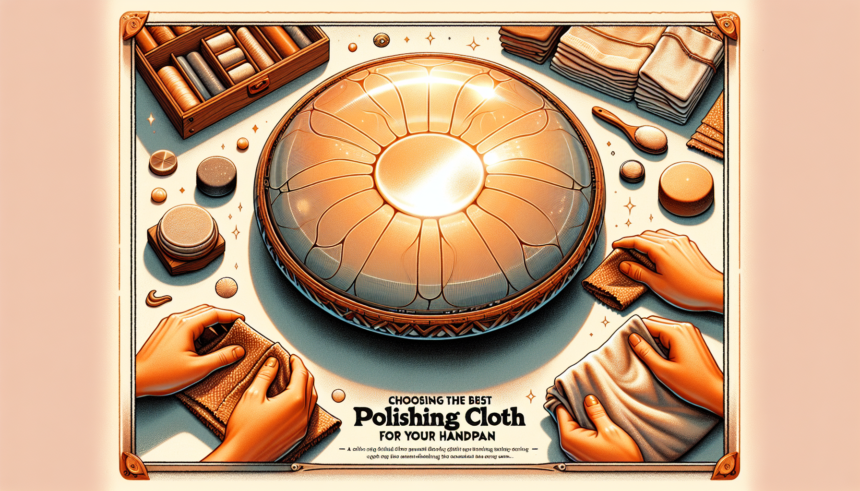Introduction to Handpan Maintenance
The handpan is a unique and beautiful instrument that requires careful maintenance to preserve its sound quality and appearance. One of the essential aspects of handpan care is regularly polishing its surface, which helps prevent rust and other forms of corrosion. However, selecting the right polishing cloth is crucial to ensure that the polishing process is effective and safe for the instrument. In this article, we will explore the different types of polishing cloths available, factors to consider when choosing one, and the step-by-step process to polish your handpan properly.
Types of Polishing Cloths
Not all polishing cloths are made equal. Here are some of the most commonly used types:
- Microfiber Cloths: Known for their softness and non-abrasive texture, microfiber cloths are excellent for polishing handpans. They can pick up dirt and oils without scratching the surface.
- Cotton Cloths: While cotton cloths are softer than many other materials, they may not be as effective at picking up fine particles or oils. They are better used in combination with a polishing agent.
- Buffing Cloths: These are specifically designed for polishing metal surfaces and often come treated with a polishing compound. They are effective but should be used with care to avoid over-polishing.
- Silk Cloths: Silk cloths are extremely soft and thus very gentle on the handpan’s surface. However, they may lack the durability required for regular maintenance.
Factors to Consider When Choosing a Polishing Cloth
Choosing the best polishing cloth for your handpan involves considering several factors:
- Material: Ensure that the material of the polishing cloth is non-abrasive. Microfiber is often a top choice due to its combination of softness and effectiveness.
- Durability: The cloth should be durable enough to withstand multiple uses without breaking down or losing its effectiveness.
- Effectiveness: Evaluate how well the cloth picks up dirt, oils, and other contaminants. High-quality microfiber cloths are particularly good in this aspect.
- Cost: While it’s tempting to go for the cheapest option, investing in a high-quality cloth can save you money and prevent potential damage to your handpan in the long run.
- Size: A cloth that is too small may be inconvenient to use, while a very large cloth might be unwieldy. A medium-sized cloth is often the most practical.
Recommended Products
Given the numerous options available, here are a few highly-recommended polishing cloths based on user reviews and expert opinions:
- E-Cloth Microfiber Cloth: Known for its exceptional ability to pick up dirt and oils, this cloth is both effective and durable.
- Kirkland Signature Ultra Plush Microfiber Towels: These towels are larger and thicker, providing excellent coverage and efficiency.
- 3M Scotch-Brite Microfiber Cloth: Renowned for its durability and effectiveness, this cloth is also widely available at a reasonable price.
- Zwipes Microfiber Cleaning Cloths: These cloths offer good quality and are affordable, making them a popular choice among handpan players.
How to Polish Your Handpan
Once you’ve selected the best polishing cloth for your handpan, follow these steps to keep your instrument in top condition:
- Prepare the Cloth: Ensure your chosen cloth is clean and free of any debris that could scratch the handpan’s surface. If it’s a new cloth, rinse it with water and let it dry before use.
- Apply a Polishing Agent: While some handpan players prefer to use only the cloth, others may opt for a polishing agent. If you choose to use one, apply a small amount to the cloth and not directly to the handpan.
- Polish the Surface: Gently rub the cloth in circular motions across the entire surface of the handpan. Pay special attention to areas with fingerprints or other visible marks.
- Inspect Regularly: After polishing, closely inspect the handpan for any areas that might need additional attention. Repeat the polishing process on those spots if necessary.
- Store Properly: After polishing, store your handpan in a cool, dry place to prevent dust and moisture buildup, which could degrade its condition over time.
Maintaining Your Polishing Cloth
Proper care of your polishing cloth is equally important. Here’s how you can ensure it remains effective for a long time:
- Wash Regularly: Hand wash the cloth in warm, soapy water to remove accumulated dirt and oils. Machine washing is also an option, but avoid using fabric softeners that can reduce the cloth’s effectiveness.
- Dry Thoroughly: Allow the cloth to air dry completely before using it again. Avoid placing it in direct sunlight, as UV light can damage the fibers.
- Store Properly: Keep the cloth in a clean, dry place when not in use. Avoid leaving it out where it can collect dust or other contaminants.





